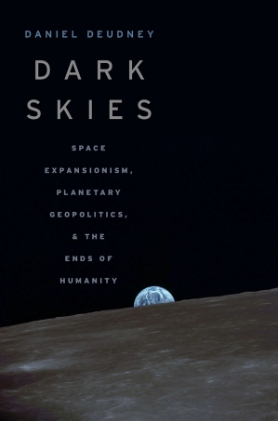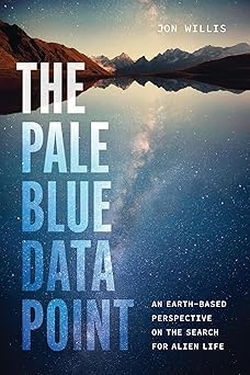Centauri Dreams
Imagining and Planning Interstellar Exploration
Kuiper Belt Oddity? Explaining Arrokoth’s Shape
Now and then people mention that our Pioneers and Voyagers made it through the Kuiper Belt on their long journey toward system’s edge, though unfortunately without operational cameras to record what they saw. A missed opportunity? Not really. Think about how long it took to find a Kuiper Belt Object like Arrokoth, the first one ever seen close up thanks to the mighty work of the New Horizons team. Without a major search to find a target, a craft passing through the Kuiper Belt is almost certainly going to encounter no objects whatsoever within range to record the details.
For now, Arrokoth, the object once known as Ultima Thule before running afoul of our times, has to serve as our example of what can emerge in this distant region, and an odd object it is. When its shape is compared to a flattened snowman, as it often is, the real story is in the word ‘flattened.’ How does this roughly 30-kilometer object emerge in the shape it’s in, and under what conditions was it spawned out there in its 298 year orbit around the Sun?
Two connected lobes are involved, as the famous image below makes clear, making this an evident contact binary, where two formerly discrete objects nudged into each other at low velocity. That part of the origin story is easy, and in fact the bi-lobed shape is not unique. We can find it in certain comets as well — consider 67P/Churyumov-Gerasimenko.
But both lobes of Arrokoth are flattened, not just one. A new paper in Nature Astronomy goes to work on the question of how this happened. Ladislav Rezac (Max Planck Institute for Solar System Research), one of the two first authors of the paper, comments:
“We like to think of the Kuiper Belt as a region where time has more or less stood still since the birth of the Solar System. There is as yet no explanation as to how a body as flat as Arrokoth could emerge from this process.”
Exactly so, because four billion kilometers out from the Sun, KBOs should have remained largely unchanged, frozen into their form in ways that give us information about that era. Yet here we have Arrokoth, whose surface seems smooth, uncratered, and again, flat. Is this shape primordial, or are we actually looking at an evolution of a cold classical Kuiper Belt Object that should have formed where we observe it today?

Image: Arrokoth’s flattened shape can only be seen from a certain perspective. The first images returned by NASA’s New Horizons spacecraft gave the impression of a “normal” snowman-shaped object. Arrokoth’s surface is surprisingly smooth and displays only few craters. Credit: © NASA/Johns Hopkins University Applied Physics Laboratory/Southwest Research Institute.
To get from there to here, Rezac and co-author Yuhui Zhao (Purple Mountain Observatory, Chinese Academy of Sciences) ran a ‘mass-loss-driven shape evolution model’ called MONET that suggests a process driving the answer, one developed in another paper earlier this year (citation below).
At the heart of the discussion is Arraokoth’s rotational axis, which is close to alignment with the orbital plane; the obliquity is about 99°. One polar region faces the Sun while the other faces away, while equatorial regions and the lower latitudes are dominated by daily variations in flux. The poles heat and release frozen gases, to produce a loss of mass which, the authors argue, produces the observed flattening over time. Thus “…the polar regions reach higher peak temperatures than the equator, due to the fact that the thermal timescales are longer than the rotational timescales, and the poles experience more sublimation than the equatorial regions.”
We wind up with symmetric erosion between northern and southern hemispheres. The process is thought to have occurred early on, perhaps in 1 to 100 million years, as volatile ices sublimated. The authors assume methane as the driving volatile for the evolution of Arrakoth’s precursor body, but add that N2, CO and CH4 ices all show active sublimation and condensation on large KBOs.
The escape of volatiles early in the formation process would not be particularly surprising, in comparison to what New Horizons found at Pluto, where larger size and stronger gravity allowed the dwarf planet to retain carbon monoxide, nitrogen and methane gases to the present era. Small bodies like Arrokoth would hardly have the gravitational attraction to hold on to these volatiles. Moreover, this may be a common part of the evolution of Kuiper Belt Objects:
This process most likely occurred early in the evolution history of the body, during the presence of supervolatile ices in the near subsurface layers. This could be the dominant process shaping the structure of KBOs if there were no catastrophic collision reshaping the body in their later history. Furthermore, while cold classical KBOs reserve their shape sculptured by early out-gassing, the structure of Centaurs and Jupiter-family comets will be further modified by the same scenario once they enter their current orbit configuration from the Kuiper belt, under sublima- tion of different volatile species. We suggest that this mechanism should be taken into account in models studying planetesimal formation and the shape evolution of KBOs, as well as other small icy bodies in regions where supervolatile ices are expected to be present.
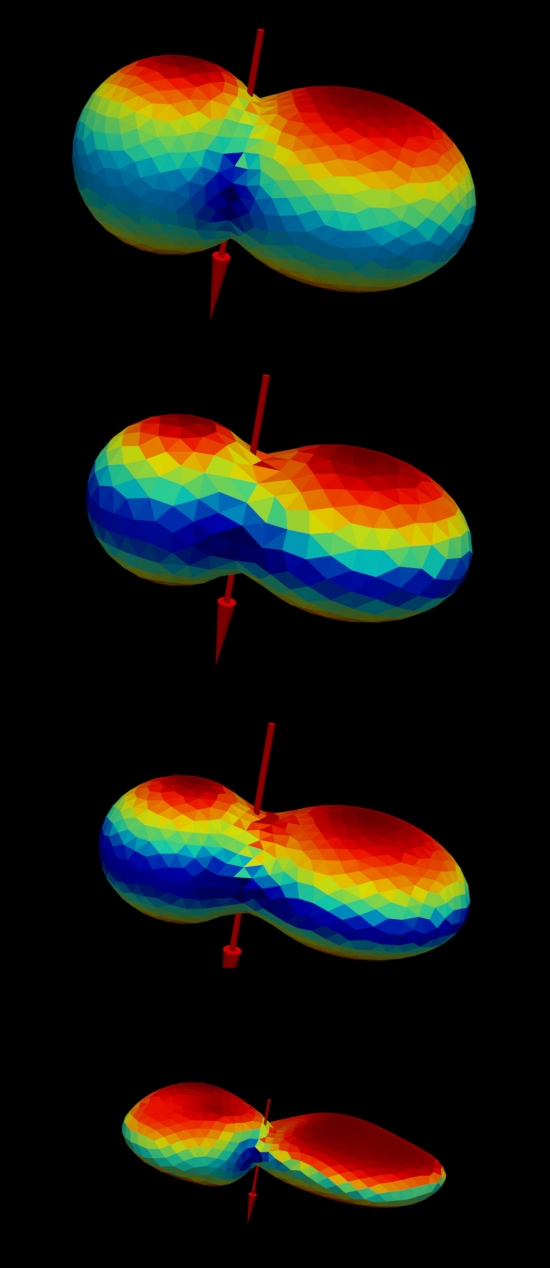
Image: Snapshots from numerical simulation of shape evolution of Arrokoth’s analogue due to sublimation driven mass loss. The bottom most shape is a digital terrain model derived from New Horizon observations. The color represents single orbit averaged temperatures. Red stands for warm and blue for cooler regions. Credit: © PMO/MPS.
The paper is Zhao, Rezac et al., “Sublimation as an effective mechanism for flattened lobes of (486958) Arrokoth,” Nature Astronomy 5 October 2020 (abstract). The earlier paper referenced above is Zhao et al., “The phenomenon of shape evolution from solar-driven outgassing for analogues of small Kuiper belt objects,” Monthly Notices of the Royal Astronomical Society 492, 5152-5166 (2020). Abstract.

The Best of All Possible Worlds
I’ve always loved the notion of ‘superhabitability,’ which forces us to ask whether, in our search for planets like the Earth, we may in our anthropocentric way be assuming that our own planet is a kind of ideal. Some scientists have been asking for years whether it is possible that the Earth is not as ‘habitable’ as it might be (see What Makes a Planet ‘Superhabitable’?). The question then becomes: What factors would make a planet a better place for life than our own?
Now Dirk Schulze-Makuch (Washington State University), working with René Heller (Max Planck Institute for Solar System Research, Göttingen) and Edward Guinan (Villanova University) runs through the characteristics of superhabitability, which take in planets that are a bit warmer than ours, a bit larger, and somewhat wetter, not to mention those that circle stars that live longer than our G-class Sun. 24 interesting planets emerge, all more than 100 light years out, but none of those so far identified meet all the specifications for superhabitability enumerated in the paper, nor could they, given the limitations on our current observing methods.
As we dig into this, let’s first remember the significance of target selection as we continue to refine our telescopes. With interesting new resources coming, space observatories like the James Webb Space Telescope and the European Space Agency’s PLATO, we will delve ever more deeply into exoplanet atmospheres.The goal here is to consider the star systems we will want to investigate as we learn how habitability works and how it might be improved upon. Choosing the list carefully is paramount, for time on these observatories will be precious.
We’ve talked before about the virtues of K-class stars, which are less massive and less luminous than the Sun, while also offering a more capacious lifetime, at minimum twice that of a typical G-class star, and in some cases quite a bit longer than that. Given that life on Earth will likely be rendered impossible within a billion years or so due to changes on the Sun, how much more useful to have tens of billions of years longer to allow life to grow and advance. Various other factors likewise come into play, among them a planet’s geothermal heat and magnetic field. The paper runs through the possibilities (and you might also want to have a look at Orange Dwarfs: ‘Goldilocks’ Stars for Life?, which contains several further citations). From the paper:
…studies of solar proxies of our Sun have shown that young dG [dwarfs of spectral class G] stars rotate > 10 times faster than dG stars near the age of our Sun, and have correspondingly high levels of magnetic dynamo-driven activity and very intense coronal X-ray and chromospheric FUV emissions (Guinan et al., 2005), which makes the origin and early evolution of life challenging. Heller and Armstrong (2014) argued that the increased life span of stars with masses lower than one solar mass may allow inhabited planets to build up a higher biodiversity and possibly even a more complex ecosystem…. This argument would lift K- and M-dwarf stars into the realm of superhabitable planet host stars.
But as the authors point out, moving the range of superhabitability into the realm of M-dwarfs is going too far — here we confront problems of tidal locking, flare activity and atmospheric loss due to the proximity of the planet to the star and exposure to a strong stellar wind. Avi Loeb and Manasvi Lingam have also written on the likelihood that K-dwarfs offer the most stable long-lived environment conducive to superhabitability, and it is worth remembering that we have a K-dwarf in the closest stellar system to our own, Centauri B in Alpha Centauri.
What would a superhabitable planet look like? A planet a bit larger than Earth — one with, say, 1.5 times Earth’s mass — would retain internal heating from radioactive decay longer, while the stronger gravity would allow the planet’s atmosphere to be retained for a longer period. A planet between 5 and 8 billion years old seems to be optimum, an age at which geothermal heat and protective magnetic fields persist. Temperature is also an interesting factor:
…higher temperatures than currently existing on Earth seem to be more favorable. The caveat is that the necessary moisture has to be available as well because inland deserts with low biomass and biodiversity are also common on our planet. One example is the early Carboniferous period, which was warmer and wetter (Raymond, 1985; Bardossy, 1994) on our planet than today, with so much biomass produced that we still harvest the organic deposits in the form of coal, oil, and natural gas from it. Thus, a slightly higher temperature, perhaps by 5°C—similar to that of the early Carboniferous time period—would provide more habitable conditions until some optimum is reached. However, this will depend on the biochemistry and physiology of the inhabiting organisms and the amount of water present.
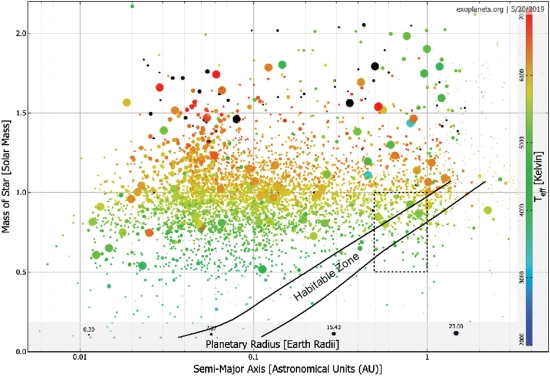
Image: This is Figure 1 from the paper. Caption: Star-planet distances (along the abscissa) and mass of the host star (along the ordinate) of roughly 4500 extrasolar planet and extrasolar planet candidates. The temperatures of the stars are indicated with symbol colors (see color bar). Planetary radii are encoded in the symbol sizes (see size scale at the bottom). The conservative habitable zone, defined by the moist-greenhouse and the maximum greenhouse limits (Kopparapu et al., 2013) is outlined with black solid lines. Stellar luminosities required for the parameterization of these limits were taken from Baraffe et al. (2015) as a function of mass as shown along the ordinate of the diagram. The dashed box refers to the region shown in Fig. 2. Data from exoplanets.org as of May 20, 2019. Color images are available online.
Here is the complete list of factors that lead to superhabitability as listed in the paper. 9 of the 24 planets identified orbit K stars, while 16 of them are between 5 and 8 billion years old. None of these worlds meet all the criteria, in any case. To be fully identified as superhabitable, a planet would meet the following benchmarks:
- In orbit around a K dwarf star
- About 5-8 billion years old
- Up to1.5 more massive than Earth and about 10% larger than Earth
- Mean surface temperature about 5°C higher than on Earth
- Moist atmosphere with 25-30% O2 levels, the rest mostly inert gases (e.g., N2)
- Scattered land/water distributed with lots of shallow water areas and archipelagos
- Large moon (1-10% of the planetary mass) at moderate distance (10-100 planetary radii)
- Has plate tectonics or similar geological/geochemical recycling mechanism as well as a strong protective geomagnetic field
As I mentioned, none of the planets of interest identified in this paper is known to have all these characteristics, but we have to keep in mind “the uncertainties in our mostly qualitative model and…the uncertainties in the observed parameters” as we examine the list. Moreover, only two of these — Kepler 1126 b and Kepler-69c — have been validated; the others continue to be planet candidates (Kepler Objects of Interest, or KOIs), and some may turn out to be false positives, while one of the confirmed worlds, Kepler-69c is, at almost 2000 light years, too far out to be a promising candidate for JWST, or even possible successors like LUVOIR.
The near-term question arising from this initial cut at superhabitability is whether we can use these criteria to find worlds closer than 100 light years, and thus accessible for high-quality observations from the TESS mission. The list of criteria presented here should help to establish observing priority for any worlds meeting a large number of these standards that can be identified in this distance range, making them high-value targets for investigating biosignatures.
The paper is Schulze-Makuch, Heller & Guinan, “In Search for a Planet Better than Earth: Top Contenders for a Superhabitable World,” Astrobiology 18 September 2020 (full text). The Lingam & Loeb paper is “Physical Constraints on the likelihood of life on exoplanets,” International Journal of Astrobiology Vol. 17, No. 2 (April, 2018), 116-126 (abstract), but see also the same authors’ later paper “Is life most likely around Sun-like stars?,” Journal of Cosmology and Astroparticle Physics Vol. 2018, May 2018 (abstract). Citations to earlier work from René Heller and colleagues on the question of superhabitability can be found in the Centauri Dreams stories I linked to above.

Dark Skies: Space Expansionism, Planetary Geopolitics, and the Ends of Humanity: A Review
While we often discuss expansion into the Solar System as a step leading to interstellar flight, the movement into space has its dark side, as author Daniel Deudney argues in a new book. As Kenneth Roy points out in the review that follows, it behooves everyone involved in space studies to understand what the counter-arguments are. Ken is a newly retired professional engineer who is currently living amidst, as he puts it, “the relics of the Manhattan Project in Oak Ridge, Tennessee.” His professional career involved working for various Department of Energy (DOE) contractors in the fields of fire protection and nuclear safety. As a long-time hobby, he has been working with the idea of terraforming, which he extended to the invention of the “Shell Worlds” concept as a way to terraform planets and large moons well outside a star’s ‘Goldilocks’ zone [see Terraforming: Enter the Shell World].
In 1997, Ken made the cover of the prestigious Proceedings of the U.S. Naval Institute for his forecast of anti-ship, space-based, kinetic energy weapons. With his co-authors R.G. Kennedy and D.E. Fields, he has appeared multiple times in JBIS and Acta Astronautica with papers on terraforming and space colonization. He is a founding member of the not-for-profit corporation Tennessee Valley Interstellar Workshop (TVIW), now operating as the Interstellar Research Group, and remains active in that organization. A graduate of the Illinois Institute of Technology and the University of Tennessee at Knoxville in engineering, Ken tells me he enjoys reading science fiction, history, alternative history, military history, and books on space colonization and terraforming.
Dark Skies: Space Expansionism, Planetary Geopolitics, and the Ends of Humanity, by Daniel Deudney (Oxford University Press, 2020).
A review by Kenneth Roy

Professor Deudney teaches political science, international relations, and political theory at Johns Hopkins University. His book can be difficult to read, in large part due to the academic writing style. Although there are a number of interesting arguments in the book, the lack of clarity and conciseness make them somewhat difficult to access. Once you get past the writing style, Deudney argues that humanity’s expansion into space will decrease the probability of human survival. Deudney raises some good questions relative to the future of Earth and actually makes a few good points applicable to humanity’s expansion into the solar system and beyond. Science fiction readers and space enthusiasts will not enjoy this book, but it is important that we try to understand and evaluate Deudney’s arguments, rather than dismiss them out of hand. You should appreciate your enemies; they will point out things that your friends and allies will never mention, things that you probably need to know.
Prometheans argue that scientific and technological advances allow for the total transformation of the human condition, a realization of utopia, with material abundance and even individual immortality. Starting with the industrial revolution, this trajectory seems to be leading to a very positive future for humanity. But around the mid-twentieth century a number of concerns surfaced suggesting a much more pessimistic end to the Promethean vision. The concerns include nuclear and biological weapons, genetic engineering, artificial intelligence, environmental collapse, and even new forms of despotism based on advanced surveillance and coercion technologies. But all technology is always a two-edged sword capable of great good and great harm depending on the intentions and even wisdom of the humans that utilize them. This is this dilemma on which Dr. Deudney bases his central argument. He seems to suggest that because the sword can indeed harm the owner, perhaps he is better off without it. Or if he absolutely must have a sword, he should made it as harmless as possible. He argues that humanity should be able to discern which technologies offer more risk than reward and should thus be proscribed while pursing technologies and policies that offer great reward for only minor risk. He argues that colonization of space and the exploitation of space-based resources belongs in the former category and should be prohibited.
But Deudney isn’t entirely anti-space. He advocates Earth-centered space activities focused on nuclear security and environmental protection. He is okay with communication and weather satellites. He believes that space activities should be used to protected the Earth rather than expand the militarization and colonization of space.
Advocates of humans expanding into space and exploiting the resources there Deudney terms “space expansionists.” He describes space expansionism as a “complex and captivating ideology…that extrapolates and amplifies the Promethean worldview of technological modernism into a project of literally cosmic scope.” He considers space expansionism to be a science-based and technology dependent religion. Space expansionists advocate for human expansion into space and believe that such expansion is desirable both for those lucky enough to work and live in space but also for humanity in general and the Earth in particular. According to Deudney, space expansionists promise humanity a permanent final frontier, as well as knowledge, and material and energy resources almost beyond measure that can help address Earth’s environmental problems. Deudney disagrees and offers a number of arguments that are discussed below.
Two worrisome technologies that Deudney identifies as being advocated by space expansionists are genetic and cybernetic technologies. The first is also termed transhumanism or the improvement of human beings through genetic manipulation. The second is machine enhancement of human bodies and minds or possibly complete replacement of humans with machines with greater intellectual and physical capability. These two developing technologies do indeed pose many ethical questions. They would be useful but not necessary for successful expansion of humanity into space. But even if the human (or transhuman or cybernetic) expansion into space were to be completely banned, the issue does not go away. The transhumanism movement and the development of cybernetic technology will proceed on Earth completely independent of space activities. There is simply too much advantage to be had for those who possess it. Humans of 2020 are not the final evolutional product and Nietzsche’s ubermensch (or Star Trek‘s Khan Noonien Sing and his augments) pose important ethical and even existential problems. But these technologies will not be avoided by restricting space expansionism.
A third technology that worries Deudney is nanotechnology. This technology enables construction of materials and machines from basic molecules. The big fear of nanotechnology is the construction of tiny machines that disassemble anything and everything they encounter and use the resulting molecules to make more of themselves, without end, until the entire planet is covered with them. This is known as the ‘gray goo’ scenario and it terminates humanity and indeed all life on the Earth. But nanotechnology is actively being pursued by numerous companies and countries because it has such tremendous potential. Nanotechnology would be very useful for space development but again, not essential.
Artificial intelligence is yet another technology Deudney, and others, are very concerned about. It offers great promise and great peril. Again, because of the potential advantages, it will be developed, and while potentially very useful for space activities is not essential.
These four technologies are intertwined, very powerful, and very dangerous. But because they are potentially so valuable, and so useful, they will be developed by someone at some point. Deudney’s fear that space expansion will accelerate their development, while possibly true, is irrelevant. They will be developed, unless a totalitarian world government using advanced surveillance and coercive technologies prevents it. In that case, the cure would be bad. Very bad, but in this particular case perhaps not as bad as the disease. Deudney fails to recognize that space expansionism offers some prospects for mitigating the risks of these technologies by allowing them to be developed in space at isolated research facilities that can be obliterated should something dangerous escape.
Deudney spends some time discussing the militarization of space. He seems to have associated nuclear-tipped missiles and the resulting nuclear annihilation risk with space expansionism simply because such weapons of mass destruction travel through space and can arrive at any point on earth minutes after launch. He doesn’t acknowledge that the first nuclear weapons were delivered by piston engine aircraft and that today hypersonic cruise missiles can deliver such warheads just fine without going into space. The Russians have nuclear-tipped torpedoes capable of destroying large harbors. Squashing the dreams of space expansionists will not in any way reduce the threat of nuclear war, and can arguably increase it due to resource depletion with increasing population pressures. Ronald Reagan’s Star Wars initiative was actually intended to prevent nuclear weapons from traveling through space, but Deudney views this effort as simply another effort at the militarization of space and thus something to be resisted.
Space (including Earth orbit) is currently effectively demilitarized. No nuclear weapons are stationed in space and no kinetic or beam weapon systems exist that can operate from space. Space technology offers the possibility of Earth orbit being filled with beneficial infrastructure such as communication, surveillance, weather, and positioning satellites, along with solar power stations and even some dirty industries. Deudney points out that with the ability to place this infrastructure in orbit comes the ability to place large weapon systems there as well. Orbital weapon systems would be capable of striking any point on Earth with nuclear, kinetic, or energy beam weapons within minutes of the decision to do so. It is the ultimate high ground and the nation that can achieve unchallenged military control of Earth orbit can dictate to the other nations of Earth, resulting in a de facto world government. But nuclear weapons can be delivered without having to travel through space, somewhat undermining Deudney’s argument.
While a world government would probably use space-based weapons to exert control over troublesome provinces, the argument that space-based weapons would lead to a world government is somewhat weak. The question of the desirability of a world government is very real but is effectively independent of the space colonization question. North Korea stands as a stark warning of what a world government might look like. Its citizens endure starvation and concentration camps while the rulers demand not just total compliance in all actions but sincere correct beliefs. Of course, the ruling elite will live very well indeed. And the North Korean political system cannot be overthrown from within. Only external forces. can remove the current system or force it to moderate its actions. A world government based on the North Korean model with advanced surveillance and coercive technologies would have no external threats to force it to moderate its actions or ever remove it from power. One possible exception to this is human colonies on Mars or in the asteroid belt. They might serve to act as the outside force keeping the world government in check, at least somewhat.
Asteroids are common throughout the solar system and occasionally will smash into Earth. Sometimes with negative consequences. Just ask the dinosaurs how that turned out for them. It has been said that asteroids are nature’s way of asking, “How is your space program coming?” Space expansionists claim asteroid protection as one reason to go into space in a big way: to protect the Earth. But Deudney points out that the ability to deflect an asteroid also implies the ability to direct an asteroid to a specific destination. With such an ability in the wrong hands this actually increases the probability of a massive asteroid impact with Earth, rather than reducing it.
Deudney suggests that space settlements have a dark side. The term space settlements as used by Deudney includes lunar colonies, artificial space habitats (O’Neil cylinders, Stanford tori, Bernal spheres, etc), asteroid settlements, and terraformed worlds. Building space settlements involves material engineering and high energies suitable for warfare. This represents a variant of the asteroid problem: in the wrong hands, this technology could do terrible things.
Terraforming is the transformation of a planet, such as Mars or Venus, to resemble the Earth and support human and other Earth life forms. Terraforming requires high energies, long time periods, and the transport of large masses around a solar system. Deudney points out that the ability to make a dead planet live also implies the ability to make a living world sterile.
In addition, space settlements individually will contain thousands, or at most a few million individuals. The life support systems and structural integrity are fragile things requiring a high degree of trust and/or control of the population to identify and remove unstable or dangerous individuals. Rather than being islands of freedom, space settlements could become, and maybe must become, micro-totalitarian states. And like the Greek city states of antiquity, they may find reasons to war amongst themselves, and perhaps with Earth. And they will war with weapons far deadlier than anything carried by the Greeks.
As space settlements are built further and further out into the outer edges of the solar system, perhaps around gas giants and their moons, they become isolated. Over time, humanity could branch into new species, perhaps unable to breed with each other. Rather than encounter aliens, we will create them. With the aid of genetic engineering and cybernetics, discussed above, this divergence could occur relatively quickly. Even with the Central Earth government and most space settlements agreeing to forgo genetic engineering and cybernetic modification of humans, it only takes one isolated space settlement to pursue this line of research to produce something quite alien and perhaps anti-human.
To the best of my ability, I have tried to identify and list here all arguments that Deudney has identified as reasons that space expansionism can decrease the probability of humanity’s survival. Many of his issues are indeed existential threats to humanity but not because of what the space expansionists propose. But they are deserving of serious consideration. These include genetic engineering, cybernetics, nanotechnology, and AI. They are real threats but also real opportunities.
Expanding into space places god-like destructive powers into the hands of those moving asteroids or large mass space freighters. In all likelihood, propulsion systems will utilize fusion power of some type, again giving god-like destructive powers of a different nature. Interstellar missions will be capable of moving large masses at some percentage of the speed of light. Take a space shuttle, run it up to only10% the speed of light and you have a planet killer. We should ensure that individuals embarking on the interstellar missions have a deep respect for, and love of, Earth. How do we protect Earth from the even one slightly deranged or evil individual who has control of an asteroid (or starship) and can direct it at a target of his, or her, choice? Space expansionists need to address this question. Are we looking at a priest-hood type space patrol, or something else?
But perhaps the big takeaway from Deudney’s effort involves government and how humanity will choose to govern itself. Globalists view a single world government as a means to reduce violence and warfare on Earth, perhaps ending the existential thread of nuclear war once and for all. Others view a single world government as a threat to freedom and a short journey to a totalitarian nightmare. But can a single world government control a solar system with dozens of lunar settlements, thousands of asteroid settlements, perhaps a couple of terraformed planets each with a growing population in the millions or even billions, and thousands of space settlements, some of which exist in the Oort cloud? Then add in genetic engineering, cybernetics, and AI, and you have something new in human experience. How is conflict resolved? Are there indeed dangerous technologies that should be proscribed, and if so, how is that done? How does all of this relate to the Fermi Paradox? Once interstellar missions are underway, the questions only multiply. It is unclear what the answer is to this problem, which does not mean that there is no solution. The space expansionist’s dreams face countless problems and this needs to be added to the list.
Deudney perhaps overstates his case and many of his arguments are flawed, but he does raise some valid points. Points that space expansionists need to address. Looking into the future, questions of how humanity deals with Star Trek‘s Khan Noonien Sing and his augments (or if you like, Nietzsche’s ubermensch) are very real and very important but separate from the space expansion question.
Deudney is also correct in that Earth is vital to future human expansion into the solar system and must be preserved at all costs. Space settlements and asteroid settlements will probably depend on living systems that must be renewed periodically by importing plants and animals and bacteria and viruses from Earth. Terraforming planets depends on life from Earth and even space settlements and terraforming efforts around distant stars will depend on life imported from Earth. Earth must be preserved for space expansionists to realize their visions.
The Universe has a number of methods available to it to sterilize entire planets. Deudney mentions asteroid impacts. He doesn’t address gamma ray bursts (GRBs). If we can deal with the unstable or evil individual problem, then space expansionists can protect Earth from asteroids and comets, and even the occasional runaway space freighter. But GRBs arrive with little warning and can irradiate Earth and other terraformed planets with intense levels of gamma rays, destroying the ozone layer and leading to an environmental disaster with eventual mass extinctions. But space settlements can be built with very heavy shielding and have no ozone problem. They could survive a GRB far better than a planet. Space-based colonies could then render aid to Earth, repairing the ozone layer and restoring the biosphere using techniques developed for terraforming.
Yes, Deudney is correct, the dreams of the space expansionists represent a two-edged sword for humanity. But sometimes a sharp sword is all that stands between you and eternal darkness.

Cometary Alignments and the Galactic Tide
A second ecliptic? What an interesting notion, referred to in a new paper from Arika Higuchi as an ’empty ecliptic,’ constituting a second alignment plane for the Solar System. This is lively stuff, examined in a new paper in the Astronomical Journal that focuses on the aphelia of long-period comets, the points where they are farthest from the Sun in their orbit. The solutions arrived at through the paper’s dense mathematics show that the aphelia fall close to one or the other of the ecliptic planes, and offer insights into comet formation.
Higuchi (University of Occupational and Environmental Health, Japan) has previously been a part of the National Astronomical Observatory of Japan’s RISE project, RISE standing for Research of Interior Structure and Evolution of solar system bodies. Her work on the orbital evolution of planetesimals goes back at least to 2007 in a paper on the formation of the Oort Cloud, considering the effects of interactions with the ‘galactic tide,’ a reference to the influence of the gravitational field of the galaxy on Solar System objects analyzed through the equations governing orbital motion. The new paper is an extension of the 2007 work, one that derives “the analytical solutions to the Galactic longitude and latitude of the direction of aphelion.”
We know that long-period comets are not confined to the ecliptic, but models of the Solar System’s formation suggest that they formed on the ecliptic and were subsequently scattered through gravitational interactions into the orbits we see today. What Higuchi finds is that even given scattering interactions with the gas giant planets, the cometary aphelia should remain near the ecliptic. That they do not necessarily do so calls for an explanation that the author finds in the influence of the Milky Way’s gravitational field. It turns out that the aphelia of long-period comets, when this influence is taken into account, tend to collect around two planes.
The first is, as you would expect, the ecliptic with which we are all familiar. The second is the ’empty ecliptic,’ a plane inclined with respect to the disk of the Milky Way by about 60 degrees, just as the ecliptic itself is inclined by 60 degrees, but in the opposite direction. Here we’re cautioned to be careful with the label, because the empty ecliptic is ’empty’ only in the early days of the system. Over time, it comes to be populated with scattered comets, a population that has implications for how we go about finding long-period comets in the future.
In the passage from the paper that follows, L and B refer to the galactic longitude and latitude of the direction of aphelion. q refers to the perihelion distance, while i refers to inclination with respect to the ecliptic plane:
The concentration of long-period comets from the Oort cloud on the ecliptic and empty ecliptic planes is an observational evidence that the Oort cloud comets were planetesimals initially on the ecliptic plane. We expect the concentrations even when we consider the effect of passing stars. Perturbations from passing stars change the conserved quantities and may break the relation between q, B, and L more or less; however, it takes a much longer time to change the eccentricity vector (i.e., L and B) than to change i (Higuchi & Kokubo 2015). Therefore, we suggest that observers, including the space mission Comet Interceptor, focus on the ecliptic plane and/or the empty ecliptic plane to find dynamically new comets.
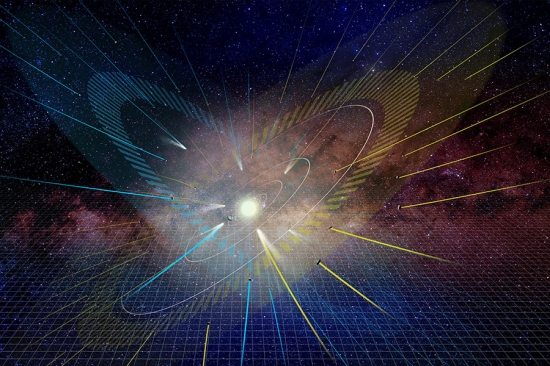
Image: Artist’s impression of the distribution of long-period comets. The converging lines represent the paths of the comets. The ecliptic plane is shown in yellow and the empty ecliptic is shown in blue. The background grid represents the plane of the Galactic disk. (Credit: NAOJ).
Higuchi cross-checked her mathematical results against numerical computations run largely at NAOJ’s PC Cluster at the Center for Computational Astrophysics. She is able to show that the analytical and computational results she derives square with the data for long-period comets listed in NASA’s Small Body Database at JPL, identifying the two peaks expected near the ecliptic and the empty ecliptic. This favors the hypothesis that long-period comets originally formed on the ecliptic. We can use upcoming surveys to refine these results. Says the author:
“The sharp peaks are not exactly at the ecliptic or empty ecliptic planes, but near them. An investigation of the distribution of observed small bodies has to include many factors. Detailed examination of the distribution of long-period comets will be our future work. The all-sky survey project known as the Legacy Survey of Space and Time (LSST) will provide valuable information for this study.”
What an interesting result. We consider long-period comets from the Oort Cloud as forming on the ecliptic plane just as the planets did, but now we move to the view that their orbital evolution must be examined not just in terms of interactions with large objects in the early system, but also with the gravitational tide of the galaxy. You’ll recall that the aphelia of various objects in the Solar System have been considered in terms of possible perturbers within the system, including hitherto undiscovered planets. Their potential for unlocking long-period comet distribution in useful ways is one I had never considered until I ran into Higuchi’s work this morning.
The paper is Higuchi, “Anisotropy of Long-period Comets Explained by Their Formation Process,” Astronomical Journal Vol. 160, No. 3 (26 August 2020). Abstract / preprint. The 2007 paper is Higuchi et al., “Orbital Evolution of Planetesimals due to the Galactic Tide: Formation of the Comet Cloud,” Astronomical Journal Vol. 134, No. 4 (29 August 2020). Abstract.

WASP-189b: An Impressive Debut for CHEOPS
The European Space Agency’s CHaracterising ExOPlanet Satellite (CHEOPS) space telescope reached space in December of 2019, achieving a Sun-synchronous orbit some 700 kilometers up. The instrument has begun its observations of stars near the Sun that are already known to have planetary companions. The idea is to use the 30 cm optical telescope to constrain radius information for these worlds, previously identified in transit and radial velocity studies.
Transiting planets are particularly useful here, because tightening up their radius measurements means we get a better idea of their density, factoring in mass estimates provided by subsequent radial velocity follow-ups. It’s great to see the instrument already hard at work, with measurements of the giant planet WASP-189b, some 325 light years from the Sun, showing us a world that is one of the hottest known, with a likely temperature around 3400?. By comparison, the surface temperature of the Sun is about 6000 ?, while smaller M dwarfs can have temperatures below that of this incendiary planet. A planet hotter than some main sequence stars.
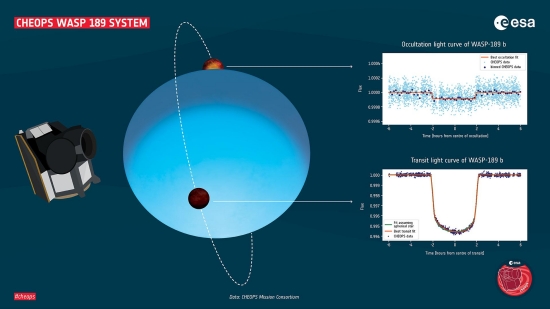
Image: CHEOPS observations of WASP-189b in front of and behind its star. Credit: ESA.
First detected in 2018, WASP-189b turns out to have an equatorial diameter of about 220,000 kilometres, making it 1.6 times larger than Jupiter, a figure 15% higher than previous estimates. Also noteworthy is its highly inclined orbit, which moves close to the poles of the star and is detected by studying both transit and occultation (as the planet moves behind the star). At 7.5 million kilometers, WASP-189b is 20 times closer to its primary than Earth, completing a revolution in a scant 2.7 days. Monika Lendl (University of Geneva), is lead author of the paper on this work:
“Because the exoplanet WASP-189b is so close to its star, its dayside is so bright that we can even measure the ‘missing’ light when the planet passes behind its star; this is called an occultation. We have observed several such occultations of WASP-189b with CHEOPS. It appears that the planet does not reflect a lot of starlight. Instead, most of the starlight gets absorbed by the planet, heating it up and making it shine.”
The A-class host star is itself notable, an object that rotates fast enough to deform itself, with an equatorial radius greater than the polar radius, so that it is cooler at the equator than at the poles. The poles thus appear brighter in the CHEOPS data because of this asymmetry, an effect that the authors are able to use to determine the spin-orbit angle of the planet. Needless to say, the planet’s highly inclined orbit raises questions abouts its formation, given that we would expect both star and planet to have developed from a common disk of gas and dust. Past gravitational interactions are likely the cause, forcing the planet to migrate inward.
From the paper:
WASP-189 b is one of the most highly irradiated planets known thus far, with a dayside equilibrium temperature of ? 3400 K (Anderson et al. 2018). It orbits an early-type star similarly to the extreme object KELT-9b (Gaudi et al. 2017), but with a longer orbital period of 2.7 days, placing it closer, in temperature, to ultra-short period planets orbiting F and G stars. As such, this object allows us to comparatively probe the impact of different stellar spectral energy distributions and, in particular, strong short wavelength irradiation on planetary atmospheres. As it is orbiting around an A-type star, the system is also relatively young (730 ± 130 Myr, see Section 2.2), providing us with a window into the atmospheric evolution of close-in gas giants.
So CHEOPS has given us a tighter look at WASP-189b, obviously useful information, but what this paper really demonstrates is the power of the space observatory at detecting extremely shallow signals, as is necessary to gauge brightness variations between pole and equator in stars like the primary here. From this we learn about the planet’s unusual polar orbit. We can look forward to measurements of much cooler planets at similar high levels of precision. The best-case scenarios, discussed in the paper, will be objects for which CHEOPS can make phase curve studies that reveal information on the distribution of clouds in planetary atmospheres The resulting transit and occultation catalog will be large and instructive.
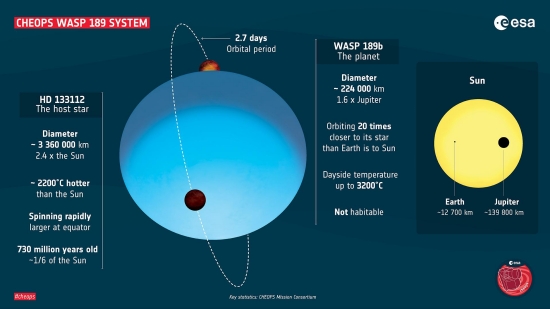
Image: CHEOPS results of the observation of WASP-189b. Credit: ESA.
The paper is Lendl et al., “The hot dayside and asymmetric transit of WASP-189 b seen by CHEOPS,” in process at Astronomy & Astrophysics (abstract / preprint).

New Approaches to the Age of Saturn’s Moons
The presence of the always intriguing Titan brings into sharper focus recent work on the age of the moons of Saturn conducted by Samuel Bell (Planetary Science Institute). Given the active weathering visible on Titan, the assumption that it is at least four billion years old, which draws on earlier work on the age of Saturn’s moon system, is challenged by the lakes, mountains, riverbeds and dunes we see in the Cassini data. Bell argues that an older Titan would have to be one with an extremely low erosion rate and minimal resurfacing.
But maybe Titan is younger than we’ve thought. Bell assembles the context of Titan in the overall system at Saturn by studying the cratering rate on the various moons. Determining the age of a planetary surface — think Mars or the Moon — is generally done by counting the impact craters and weighing this against the cratering rate. At Saturn, the problem is that the cratering rate is not known. It would be one value if, as previous work has assumed, the craters on the Saturnian moons all came from objects orbiting the Sun. Bell wondered if this was true:
“If the impacts came solely from Sun-orbiting objects, the relative cratering rate would be much, much higher the closer the moons are to Saturn. However, the crater densities of the oldest surfaces of Mimas, Tethys, Dione, Rhea, and Iapetus are all relatively similar. It would be too much of a coincidence for the ages of the oldest surfaces on each moon to vary by the exact amounts necessary to produce broadly similar crater densities. As a result, it seems much likelier that the impactors actually come from objects orbiting Saturn itself, moonlets that would be too small to detect with current technology.”
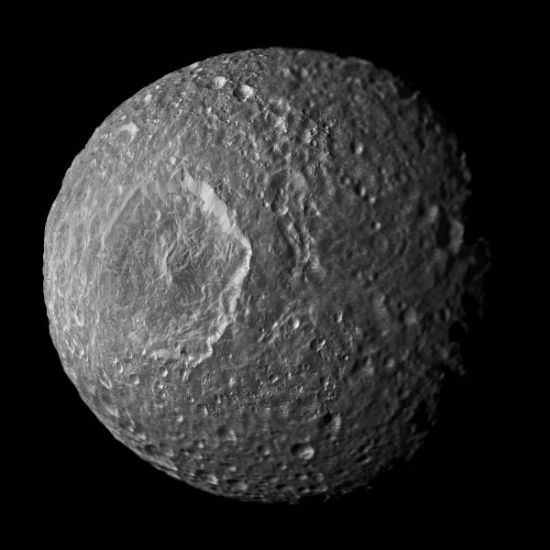
Image: This mosaic of Saturn’s moon Mimas showing its cratered surface was created from images taken by NASA’s Cassini spacecraft. Credit: NASA/JPL-Caltech/Space Science Institute.
A new chronology emerges if we accept this model. Saturn-orbiting impactors allow a younger age to be calculated, one that, for Titan, more clearly squares with the Cassini data.
Relative Crater Scaling Between the Major Moons of Saturn: Implications for Planetocentric Cratering and the Surface Age of Titan https://t.co/nsup2gYqUZ I think most impactors come from debris orbiting Saturn. Under this theory, Titan is probably younger than the other moons. pic.twitter.com/v4cTwtfS5R
— JGR-Planets (@jgrplanets) July 10, 2020
Bell is clear about the factors of system age that we have yet to explain, and acknowledges than an older Titan is still possible. From the paper:
I… prefer a model of dominantly planetocentric cratering, with an impactor production function that probably does not vary by more than a factor of ~5 between Mimas and Iapetus. This planetocentric cratering model makes the young moons hypothesis possible and implies that the cratered plains of Mimas, Tethys, Dione, Rhea, and Iapetus are of broadly similar age. Under this model, the surface of Titan is definitely younger than the cratered plains of Rhea and Iapetus, and it could easily be much, much younger. However, due to lack of constraints on the planetocentric cratering rate and how it varies with time, the planetocentric model provides very limited constraints in terms of
absolute age. While it suggests a vigorously resurfaced Titan with a young surface, the model cannot rule out a surface of Titan that dates back to the early solar system, a very old surface with a very slow erosion rate and negligible endogenic resurfacing.
I bring all this up this morning to add context to a 2019 paper on Saturn’s moons from Marc Neveu (NASA GSFC) and Alyssa Rhoden (Southwest Research Institute). In “Evolution of Saturn’s Mid-sized Moons,” the duo make the case that the orbits of Mimas, Enceladus, Tethys, Dione and Rhea are hard to square with their geology. From their paper:
The moons’ ages are debated. Their crater distributions, assuming Sun-orbiting impactors extrapolated from present-day observed small-body populations, suggest surfaces billions of years old. Conversely, the measured fast expansion of their orbits, probably due to tides raised by the moons on Saturn, indicates— assuming dissipation levels that are constant over both time and frequency of tidal excitation—that this relatively compact moon system is less than a billion years old. This could explain why some moons may not have encountered predicted orbital resonances, and supports scenarios of non-primordial formation from debris of the tidal or collisional disruption of progenitor moons.
The scientists have run numerical simulations coupling geophysical and orbital evolution over a 4.5 billion year period, with the orbits expanding with time through tidal effects. For the overview, let me just quote the abstract below, as I’m short on time this morning. But notice the ramifications of system age for another interesting moon, Enceladus:
Dissipation within the moons decreases their eccentricities, which are episodically increased by moon?moon interactions, causing past or present oceans to exist in the interiors of Enceladus, Dione and Tethys. In contrast, Mimas’s proximity to Saturn’s rings generates interactions that cause such rapid orbital expansion that Mimas must have formed only 0.1?1 billion years ago if it postdates the rings. The resulting lack of radionuclides keeps it geologically inactive. These simulations explain the Mimas?Enceladus dichotomy, reconcile the moons’ orbital properties and geological diversity, and self-consistently produce a recent ocean on Enceladus.
But back to Samuel Bell, who is clearly right about how meager our knowledge of the evolution of this system of moons really is:
“With the new chronology, we can much more accurately quantify what we do and don’t know about the ages of the moons and the features on them. The grand scale history of the Saturn system still hides many mysteries, but it is beginning to come into focus.”
The paper is Bell, “Relative Crater Scaling Between the Major Moons of Saturn: Implications for Planetocentric Cratering and the Surface Age of Titan,” Journal of Geophysical Research Planets 26 May 2020 (abstract). The Neveu and Rhoden paper is “Evolution of Saturn’s mid-sized moons,” Nature Astronomy 3 (1 April 2019), 543-552 (abstract).

